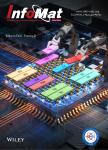Advanced low-dimensional carbon materials for flexible devices
作者机构:School of Electrical and Electronic EngineeringNanyang Technological UniversitySingapore
出 版 物:《InfoMat》 (信息材料(英文))
年 卷 期:2020年第2卷第4期
页 面:698-714页
核心收录:
学科分类:08[工学] 0805[工学-材料科学与工程(可授工学、理学学位)]
主 题:1D/2D materials carbon nanotube flexible electronics graphene
摘 要:We live in a digitized era,where we are completely surrounded by a plethora of automated electronic systems,be it a smart home energy controller or a selfoperated diagnostic kiosk in a clinic.With the recent advent of onedimensional(1D)and two-dimensional(2D)nanomaterials like carbon nanotube(CNT)and graphene,the world of electronics has revolutionized with state-of-the-art product paradigms.These nanomaterials possess desirable features of large surface area,excellent electrical conductivity,and high mechanical strength.Electronic devices made out of these materials have the added advantages of being flexible,light-weight,and durable.Thus,presentday devices that utilize these substances as channel or electrode materials have been able to undergo a positive transformation as compared with conventional structures.Flexibility and bendability are some of the coveted aesthetics of modern-day electronics and the use of these 1D and 2D nanomaterials imparts such features to the devices,without having to compromise on key output characteristics like sensitivity and efficiency.In this short review,we discuss about various new configurations that are based on graphene,CNT,and other materials like transition metal dichalcogenides,and how these materials have been able to metamorphose the attributes of conventional devices.



